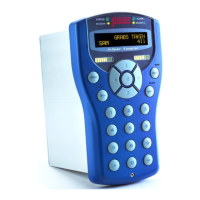• Port 1 → Display (Not Configurable)
• Port 2 → Off
• Port 3 → Off
2.9.5 MODBUS TCP SLAVE
This menu item allows you to setup Modbus TCP slave. You are prompted for the Modbus
string size, the float word order and the long word order. These items are covered in the serial setup
above. Note that setting up Modbus TCP slave is simpler than serial Modbus slave. There is no node
number. The IP address of the machine is the unique identifier. There is also no need to set up the RS-
mode, protocol mode, baud rate or parity.
2.9.6 MODBUS TCP MASTER
This menu option enables you to setup Modbus TCP Master. You are prompted for the query
block (the device), the associated block URL (IP address), the Modbus start offset, the Modbus string
size, the float mode (32 bit or 64 bit) and the float and long word orders. You are then prompted to edit
the specific master queries, entering a node for specific devices on the network.
2.9.7 IP SETTINGS
Note: As an operator of the InSpec you may not understand or appreciate the specific
details and needs of each IP setting. If you wish to enable the IP features of this controller then
you will almost certainly configure the IP settings in conjunction with the authorised local InSpec
engineer and your local network administrator. There is a more detailed section in the manual
concerning these points and one that can be presented to the local network administrator if
required. See section 0 for a more in-depth look at the IP settings required to deploy the InSpec
onto a network and use the related features.
CONFIGURE DHCP
The Dynamic Host Configuration Protocol (DHCP) is a computer networking
protocol used by hosts (DHCP clients) to retrieve IP address assignments. In this
menu you are first asked if you wish to enable DHCP, if it is disabled the user will have
to enter static IP addresses etc. If you select yes, you are prompted for the DHCP
timeout period. The default is 30 seconds. This is the period after which a poll to the
DHCP server is considered to have failed/timed out.
INSPEC IP ADDR
This item allows you to view the current IP address and to set a static IP
address if required. Note: If DHCP is enabled and working then the IP address you
see via the view IP address menu item is the IP address that has been provided by
DHCP server.
SUBNET MASK
A subnetwork, or subnet, is a logically visible, distinctly addressed part of a
single Internet Protocol network. The process of subnetting is the division of a
computer network into groups of computers that have a common, designated IP
address routing prefix. By default, this is set to 255.0.0.0 within the InSpec. If DHCP is
enabled, then the subnet mask is obtained from the DHCP server. However, you can
still enter a static subnet mask address. This will then act as a fall-back if the DHCP
server fails to provide the subnet mask address or DHCP is disabled in the InSpec.
Naturally, the specific configuration you chose will depend on the advice of your local
network administrator.
DEFAULT GATEWAY
The default gateway is used to connect the internal networks and the outside
network (Internet or intranet). If DHCP is enabled the default gateway is obtained from
the DHCP server. However, you can still enter a static default gateway. This will then
act as a fall back if the DHCP server fails to provide a default gateway or DHCP is
disabled in the InSpec. Naturally, the specific configuration you chose will depend on
the advice of your local network administrator.

